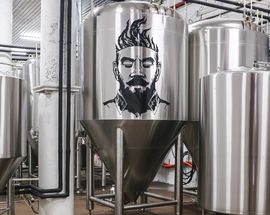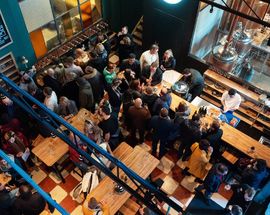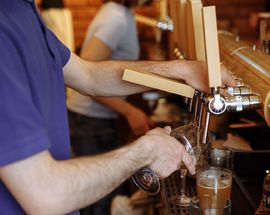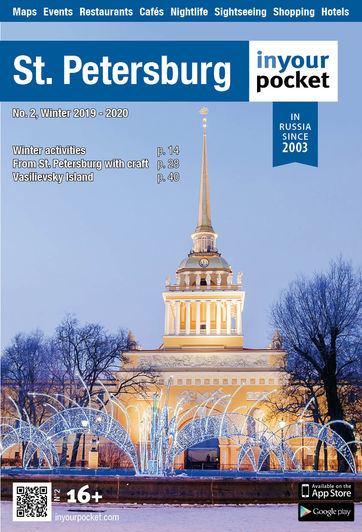Russian beer. From St. Petersburg with craft
more than a year agoIn St. Petersburg spring doesn’t come on the 1st of March. Rather, according to some locals, it starts when you are able to have your first beer on the embankment of the Neva River. Although drinking in public places is prohibited, it doesn’t stop residents from sitting on granite stones or standing by the cast iron railing, getting their northern suntan on and enjoying a few alcoholic beverages with some friends. It is also symbolic that industrial-scale production of beer appeared in Russia together with the foundation of St. Petersburg in 1703.
A look into the history
It doesn’t mean Russians didn’t brew this drink, they did so since the olden times. Back then it was known as “perevar”. This alcoholic drink made from honey and beer is mentioned in old Russian birch bark manuscripts, dating back to the XI—XV centuries. In the Tsar’s laws it was first mentioned during the reign of Ivan III (1462-1505), when the brewing process was taken under state control. Later, when special taxes were introduced, only certain groups of people were allowed to brew, while peasants could do it just several times a year for big holidays. But beer making as an industry was established in Russia only in the early XVIII century.
In 1697 Tsar Peter I started his Grand Embassy - a diplomatic mission with the goal of securing allied support against the Ottoman Empire. During the 18-month journey around Europe he met with foreign leaders and diplomats in Amsterdam, London, Leipzig, Dresden, and Vienna. He also worked as a shipbuilder, acquired vast maritime knowledge and met many scientists. Politics aside, he also learned about how Europeans lived, what they wore and consumed. It’s known that Peter fell in love with the porters and stouts that were commonly drunk by British dockworkers. So it’s no surprise that together with European architects, army officers, shipbuilders and other specialists, foreign brewers were among the first residents of the new capital. And as water is crucial for beer making, the city on the Neva River was suitable for it.
These days it keeps its leading positions, as the local Baltika beer brand (now part of the Carlsberg Group) occupies about 30% of Russia’s domestic market. At the same time St. Petersburg, known as the city of three revolutions, became a place of the “craft beer revolution” in the second decade of the XXI century. When we hear the term “craft beer”, we usually think of beer that’s the complete opposite to the mass market sorts. It is brewed in a variety of styles and usually ignored by giant breweries because of their complexity and difficult technological aspects. According to Pavel Yegorov’s article “History of craft beer in Russia” published on the thematic web-site Profibeer.ru: “A lot of interesting beer variations, which we would call craft beer now, were brewed from 2010 to 2012 by the experimental microbrewery installed at the Baltika brewery in St. Petersburg: this is Russian imperial stout, strong rye ale (17 % of alcohol makes it probably the strongest beer variety brewed in Russia)… and many more”. Only a few could try this beer because it was only distributed free of charge at various presentations and festivals.
Sergey Grigoriev, the head of Mager brewery, was actively involved in the process: “Offi cially, the first craft was Snobish Pale Ale made in 2010 at the experimental Baltika brewery especially for Magerfest, which I organized. It was a completely non-commercial project, as Baltika could easily aff ord it”. Sergey is one of the pioneers of Russia’s craft revolution, so he considers the first revolutionaries as those who could risk their own money and represent the beer on the open market. “My enterprise became the first commercial contract brewery”, Grigoriev says. “In 2011 at the brewpub Brasserie de Metropole we presented a beer brewed according to the Belgian tradition, which I called ‘Le Grand Nid’ and dedicated it to the birth of my son. Later on, we made another sort – A.C.A.B. and had several collaborations with different brew masters”.
Beer expert and collector Pavel Yegorov considers another St. Petersburg company to be the first one - Knightberg, “which brewed beer according to its own recipe at the brewery in Kondopoga [a town in the Republic of Karelia, located 335 km north from St. Petersburg] while its own capacities were installed”, stated Yegorov in his article. The expert points out that already in 2010 “the first IPA Krasnaya Mashina (Red Machine) was brewed in collaboration with home brewer Zhenya Tolstov also by Knightberg. Later, in 2012, the Vasileostrovskaya Brewery and contract brewery AF Brew also presented their IPAs. Since that year we can talk about the emergence of such a phenomenon as craft beer in Russia”, concludes Yegorov in his article. Experts have not yet reached a consensus on the amount of breweries in St. Petersburg, as the market is constantly developing. Still, there are several major players who turned their hoppy hobby into a serious business
with exports overseas.
Who is who on the local craft beer scene?
AF Brew Taproom – the most atmospheric place to start you beer tour. Located in the industrial part of the historic center, it occupies several former workshops of the Stepan Razin brewery, which was founded in 1795. In 2005, Heineken bought the factory and moved the production to modern venues. Late XIXth century halls with arches and columns were neglected, but thanks to Nikita Filippov and other AF Brew cofounders, the historic site got a new lease on life. “In 2012 we started the brewery as Anti Factory”, Filippov says. “This was the romantic and revolutionary stage of our business. Considering the fact that 2 out of 3 initial cofounders worked at the Baltika Company, we gave this name to our craft project to make it a contradiction”.
Filippov explains that there was a transition period when they brewed their beer with small portions once every 2 months and only 1.5 year later they were able to leave Baltika. These days they produce 100,000 liters per month [200,000 standard 0.5 liter bottles], although about 45% is draft beer, distributed in kegs. They take part in international festivals, export their brands to 15 countries and produce non-alcoholic drink kombucha since summer of 2019. Established as a contract brewery, they built their own “factory” in 2016, which tourists can visit during an organized tour. It includes a 30-40 minute excursion followed by a degustation of 3-4 types of beer and a set of Indian food. Another location to try AF Brew production is Redrum Bar on Nekrasova Street, which has become a new party area in last few years. It offers Scandinavian cuisine and 24 taps of beer (both local and imported). Just a few sorts are served at Camorra Pizza – AF Brew food project, which has 3 venues in St. Petersburg at the moment.
Bakunin Brewery was started in 2013 as a bar and bottle shop where beer geeks could try extraordinary imported beers. Nowadays, they create their own sorts and have 2 more locations in St. Petersburg. As Bakunin bartender Artur explains, the company picked the name of the XIXth century philosopher on purpose. Mikhail Bakunin was a Russian revolutionary and the founder of collectivist anarchism. And if we speak about craft beer, it historically represents a certain anarchy in the world of traditional beer making. “We have a contract production and use capacities of other breweries located in Leningrad Region and Latvia. Foreigners often visit our bar, especially our neighbors from Scandinavian and the Baltic countries”, Artur says.
Canadian expat Josh Nadeau started to appreciate the Russian craft beer scene only after he started freelancing as a translator for the brewery: “I like the original Bakunin Bar near Vosstaniya Square because that’s where my friends and I hang out most out of the three places. It’s a little out of the way so there isn’t the kind of traffic you see on Nevsky Prospekt”. Josh recommends trying such regular offerings as Moloko+ Milk Stout and Zatmenie Russian Imperial Stout, but also values the unpredictability of local craft: “I really liked this one wild cherry limited edition beer a few years back, but that’s long gone now. This is one of the things I enjoy about bars like this: you don’t know what’s going to stay and what’s going to be on rotation. You have to enjoy what’s there in the moment because you don’t know what’ll be there tomorrow”.
While there are no barley and hop fields around St. Petersburg, the region is rich in apple trees. When a former lawyer Alexey Beletsky couldn’t cope with the huge apple harvest at his dacha [countryside house], he came up with the idea of his current business – to make cider. Started as a hobby in 2014, he established his company with friends a year later. “We named it On The Bones | Toksovo Cidrerie” says Alexey, whose dacha is located in Toksovo, an urban-type settlement located 20 km north of the city. “We have a contract production and the bar called Yasli. We are not owners of the bar, but we work there as a managing company, that’s why you can always fi nd our cider and beer there. We belong to the early wave of St. Petersburg craft beer makers and we are definitely pioneers in cider production in the North-Western region”, he continues.
Apples are collected from local farmers and dacha owners of Leningrad, Novgorod and Pskov regions. But there are high risks in this sector, as the quantity of cider depends on the harvest. That’s why the company expanded into beer making: “How did we start? We were a group of friends, everyone donated a bit of their savings and we brewed a ton of beer – that’s it. It was a novelty, the market wasn’t very full and people did it for fun, just as a hobby”, explains Beletsky. These days On The Bones continues to experiment and sometimes brews drinks abroad, for example in Finland and Spain where the guys collaborated with local producers. Recently they’ve updated their “cider map”, and of course they hope for a great apple harvest in 2019.
Pivmasteria 17M is another location where you can witness the mysteries of brewing, as visitors can watch the process through a huge glass wall. Opened in Sevkabel Port in 2018 it offers its capacities to several small breweries and even those individuals who would like to produce one tank of beer (360 liters) for their birthday. “I work here as a ‘translator’ - I translate everything from human language into the language of a technologist”, says Sergey Grigoriev, one of the pioneers of Russia’s craft beer scene. Using his rich experience, he assists various beer makers, gives tours at Pivmasteria 17M and brews his own sorts there under the Mager brand. Mager is his nickname and “the virtual brewery which exists only in my head”, Grigoriev says with the smile.
The brewery shares the space with Gypsy Fish & Taproom, and both venues are located in the former boiler house of Sevkabel factory. These days Sevkabel Port works as a creative cluster and has a stunning view of the Gulf of Finland, so it is logical that fish and sushi dominate the bar’s menu. “You can try the production of our contract breweries”, Sergey recommends. “There are 28 taps, and some of them are ‘transitional’ craft beers, not very extreme. They are ideal for those who just discovered the craft culture”, he adds.
Baltika factory tour
If you are a bit tired of St. Petersburg’s palaces and would like to see the industrial part of the city, then head to Parnas metro station (it is the last one on the top of the blue line) and visit the Baltika factory. Opened in 1990, it became one of the pioneers of brewing in modern Russia. “There were two kinds of beers in the Soviet Union”, said our guide Olga. “There is beer today, there is no beer today”, she continued with a smile. But after the joke she explained that originally Baltika was supposed to produce just Zhigulevskoye beer (one of few types of beer available), but the company came up with their own brands – Baltika with numbers from 0 to 9 respectively (although they don’t produce #1 and #5). Numbers don’t reflect the strength of the beverage, but just define different kinds of beer.
These days the factory is part of the Carlsberg Group, and its beer is exported to 75 counties. It has 8 factories in Russia and 9,000 employees in total. There are very few people in workshops, as the production is almost automated. Still you will be able to see all stages of brewing, gigantic 350-tons tanks and the storage with a square meterage bigger than several football fields.
The degustation is probably the funniest part of the tour: participants can try up to 6 kinds of beer (including non-alcoholic options if that’s what your circumstances require). The price of the tour is 500Rbl, it includes the degustation and a present from the company. There are regular tours in Russian, which you can join if you have a friend who will be your personal translator (you can sign up through the www.corporate.baltika.ru/excursion).








Comments